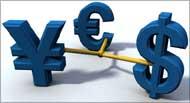There is a need for coordination among emerging economies on managing capital flows and exchange rates, and China's exchange rate policy can help. That it is ready to be more flexible is welcome, writes Arvind Subramanian.
Necessary adjustments in global imbalances are underway. China's current account surplus is down from a peak of 11 per cent to about 6 per cent in 2009 while the US deficit is also well down from its peak of 6 per cent. It is possible that these imbalances will re-emerge but estimates of future surpluses in China are being furiously revised downwards.
 Even if and as global imbalances recede as a problem of the 'oughties', though, the contours of the next imbalance are becoming clear. And China's exchange rate is central to that imbalance too.
Even if and as global imbalances recede as a problem of the 'oughties', though, the contours of the next imbalance are becoming clear. And China's exchange rate is central to that imbalance too.
Essentially, the irresistible tidal force of capital flows to emerging economies is encountering only partially movable currencies. The tidal wave is being caused by a perfect confluence of push and pull factors that are sharply increasing returns to capital in EMs relative to those in advanced economies. And the magnitudes of flows are likely to surpass pre-crisis levels.
The dominant pull factor is the contrasting underlying performance of emerging economies, especially in Asia, which are soaring back, while advanced economies, especially in Europe, are doing so anemically.
As a result, the growth differential between these two sets has become large and widening, surpassing levels reached in 2007, another year of buoyant flows to EMs.
An important push factor is related to the above. With these different sets of economies at different stages of the cyclical recovery, monetary policy stances stand in contrast.
With inflation still quiescent, monetary authorities in advanced economies are likely to withdraw policy support only gradually. In contrast, emerging economies have started to tighten monetary policies either to head off incipient inflationary pressures (China, India and Indonesia) or simply to unwind the earlier monetary accommodation as growth returns to normal.
Thus, substantial interest rate differentials in favour of emerging economies are becoming a reality, further pushing capital from advanced to emerging economies. Problems in Greece and consequential contagion in Europe might only further aggravate capital flows to emerging economies.
How have emerging economies responded? Essentially through massive accumulation of foreign exchange reserves, the pace of which resembles that in the pre-crisis period. It is not that emerging economies have not let their currencies appreciate in response to flows.
Rather, as a matter of policy choice, upward currency flexibility has been limited. The irony, of course, is that the policy choice - to buy up flows and allow only limited flexibility - aggravates the imbalance. The more inflexible are exchange rates, the greater the pull for capital flows, because of the one-way bet that is created by policy.
How can this imbalance be resolved? To the extent that some flows are unavoidable and even desirable, emerging economies have to be ultra-vigilant in preventing overheating of goods and asset prices domestically. Here there is reason for optimism.
Especially in Asia, the experience of and lessons from the late-1990s crisis and that of the recent one have been firmly etched in the collective DNA. The nineties' crisis in emerging economies taught them what not to do while the oughties' crisis that emanated elsewhere affirmed the prudent policy choices made in the intervening years.
But emerging economies will want to moderate inflows of capital both for macroprudential reasons and for limiting competitiveness losses from rising currency values. What should they do? The only two real options are capital controls and currency appreciation. But what is becoming clear in this cycle is that the landscape is rife with beggar-thy-neighbour possibilities. For example, if some countries restrict capital, there is the risk that capital gets diverted to others, increasing pressure on them. And competitive non-appreciation - the revealed preference of many emerging economies given that their main trade competitor, China, has a fixed exchange rate - imposes large systemic costs, of global overheating and excess liquidity creation, as reserves pile up around the world.
The policy lesson is clear, and that is the need for coordination amongst emerging economies on managing capital flows and exchange rates. Key to facilitating this coordination is China's exchange rate policy. It is a welcome development that China has signalled that the renminbi will be more flexible, going forward.
But its likely policy of gradualism risks being overtaken by events. Given the tidal wave of capital flows, a small move by China will probably only elicit a small move by other countries, especially in Asia. Given the widely held belief about the magnitude of eventual appreciation, the one-way bet will remain largely intact, with not much dampening effect on flows.
Rectifying the new imbalance will, in this environment, require a more ambitious move by China. With that in place other emerging economies can follow suit and allow more flexibility in their own currencies. De facto policy coordination is possible and China moving soon and substantially can help bring that about.
The author is Senior Fellow, Peterson Institute for International Economics and Center for Global Development